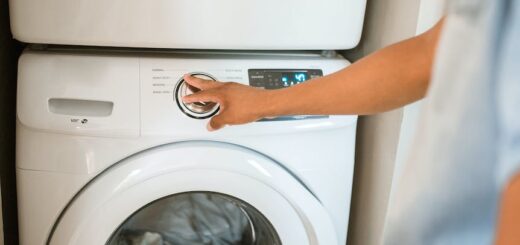8 Reasons Your GE Washer Stuck On Sensing (Quick Fix!)

Are you frustrated with your GE washer getting stuck in the sensing mode? Did you know that this issue affects a significant number of GE washer owners? Well, you’re not alone! But don’t worry, there’s good news.
In this article, we’ll explore eight common reasons why your GE washer may be stuck on sensing, and we’ll provide quick fixes that you can easily try yourself.
From drainage issues to faulty lid switches and malfunctioning timers, we’ll cover all the potential culprits that could be causing this problem.
By the end of this article, you’ll have the knowledge and solutions to get your washer back on track and your laundry routine running smoothly again.
Drainage Issues
If your GE washer is frequently getting stuck on the ‘Sensing’ cycle, it could be due to drainage issues. Common causes of drainage issues in GE washers include a blocked water filter, a blocked drain line or hose, and a clogged drain pump.
To troubleshoot a clogged drain pump in a GE washer, follow these steps:
- First, unplug the washer and turn off the water supply.
- Locate the drain pump, which is usually at the bottom of the machine.
- Remove any debris or foreign objects from the pump.
- Check the pump for any signs of damage or wear, and replace if necessary.
- Once the pump is clear and in good condition, reconnect everything and start a new cycle to see if the issue is resolved.
Faulty Lid Switch
To determine if a faulty lid switch is the cause of your GE washer getting stuck on the ‘Sensing’ cycle, check for any issues with the lid switch. The lid switch is a safety feature that prevents the washer from spinning if the lid is open. If the switch is malfunctioning, it may falsely detect that the lid is open, causing the washer to remain stuck on the ‘Sensing’ cycle.
Common symptoms of a faulty lid switch include the washer not starting or stopping mid-cycle. To troubleshoot the issue, you can visually inspect the lid switch for any visible damage or loose connections. If you find any issues, common repairs include replacing the lid switch or tightening the connections.
Potential DIY fixes include cleaning the lid switch or adjusting its position. Alternatively, you can consult a professional technician for assistance.
Faulty Shift Actuator
Sometimes, the faulty shift actuator can cause your GE washer to get stuck on the ‘Sensing’ cycle. The shift actuator is responsible for shifting the washer’s gears and controlling the motor’s direction. When it malfunctions, it can prevent the washer from moving on to the next cycle. If you’re experiencing issues with your shift actuator, here are some troubleshooting steps you can take:
| Possible Issues | Solutions |
|---|---|
| Loose wiring connection | Check the wiring connections and ensure they are secure |
| Faulty shift actuator | Replace the shift actuator |
If you’ve determined that the shift actuator is the cause of the problem, you can replace it with a new one. To do this, follow these steps:
- Unplug the washer and turn off the water supply.
- Remove the top panel of the washer.
- Locate the shift actuator, usually found near the motor.
- Disconnect the wiring harness and remove the screws holding the actuator in place.
- Install the new shift actuator by reversing the steps above.
Malfunctioning Timer
A common cause for your GE washer getting stuck on the ‘Sensing’ cycle is a malfunctioning timer. The timer is responsible for regulating the different cycles of your washer, and when it malfunctions, it can cause your washer to get stuck on one cycle, like ‘Sensing’.
Here are some troubleshooting tips for a GE washer with a malfunctioning timer:
- Reset the timer: Sometimes, a simple reset can fix the issue. Unplug the washer from the power source for a few minutes and then plug it back in. This can help reset the timer and resolve any temporary glitches.
- Inspect the timer for damage: Check if the timer is damaged or worn out. Look for any signs of burnt wires or loose connections. If you notice any damage, you may need to replace the timer.
- Replace the timer: If resetting and inspecting the timer doesn’t solve the problem, it may be necessary to replace the malfunctioning timer. Consult the user manual or contact a professional for guidance on how to replace the timer in your specific GE washer model.
Loose/Damaged Wiring
Check for any loose or damaged wiring in your GE washer to troubleshoot the issue of it getting stuck on the ‘Sensing’ cycle. Loose or damaged wiring can disrupt the circuit connection, causing the washer to malfunction.
To address this problem, start by unplugging the washer and carefully inspecting the wiring connections. Look for any loose or frayed wires, as well as any signs of damage or corrosion.
If you find any issues, tighten loose connections or replace damaged wiring. It’s important to ensure a secure and proper circuit connection to prevent the washer from getting stuck on the ‘Sensing’ cycle.
Regular wiring maintenance is also recommended to prevent future issues.
Wrong Setting
If you’re experiencing your GE washer getting stuck on the ‘Sensing’ cycle, one potential reason could be that you have selected the wrong setting. It’s important to choose the appropriate setting for your laundry load to ensure the proper functioning of the washer. Here are some troubleshooting tips and common mistakes to avoid:
- Check the user manual: Refer to the user manual or the control panel for the correct settings for different types of loads, such as delicate, normal, or heavy.
- Select the right cycle: Make sure you have chosen the correct wash cycle for your specific laundry needs, such as quick wash, bulky items, or whites.
- Adjust the water temperature: Verify that the water temperature setting aligns with the garment care instructions to avoid damaging your clothes.
Plug Corrosion
To fix your GE washer stuck on the ‘Sensing’ cycle, address the issue of plug corrosion. Plug corrosion can cause a poor electrical connection, preventing the washer from functioning properly. One of the causes of plug corrosion is moisture exposure, which can lead to rust and oxidation.
Another cause is the buildup of dirt and debris on the plugs or connectors. To prevent plug corrosion, make sure to keep the area around the plugs clean and dry. Regularly inspect the plugs and connectors for any signs of corrosion and clean them with a wire brush if necessary. Applying dielectric grease to the plugs can also help protect against corrosion.
Frequently Asked Questions
How Can I Test if the Water Filter Is Blocked in My GE Washer?
To test if the water filter is blocked in your GE washer, first, turn off the power. Disconnect the water supply and remove the filter. Inspect it for debris or clogs. If necessary, clean or replace the filter before reconnecting and testing the washer.
What Are the Signs of a Malfunctioning Lid Switch in a GE Washer?
If your GE washer has a malfunctioning lid switch, you may notice that the machine won’t start or won’t advance to the next cycle. To troubleshoot, check for a loose or broken switch and replace if necessary.
Is It Possible to Replace the Shift Actuator in a GE Washer on My Own?
Yes, you can replace the shift actuator in your GE washer on your own. Start by troubleshooting the control panel to confirm the issue. Follow the manufacturer’s instructions and use the appropriate tools for a successful replacement.
Are There Any Troubleshooting Steps I Can Take to Determine if the Timer in My GE Washer Is Malfunctioning?
To troubleshoot a malfunctioning timer in your GE washer, start by testing the water filter for blockage. If the filter is clear, it may indicate a timer issue. Consult the manual or seek professional help for further diagnosis and repair.
How Can I Check for Loose or Damaged Wiring in My GE Washer?
To check for loose or damaged wiring in your GE washer, start by unplugging it. Then, inspect the power cord and connections for any visible signs of damage or loose wires. If necessary, consult a professional for further troubleshooting.
Conclusion
In conclusion, dealing with a GE washer stuck on sensing can be frustrating, but there are simple fixes for this common issue.
By addressing drainage problems, checking the lid switch and shift actuator, and ensuring proper settings and wiring, you can get your washer back on track.
Just like a well-oiled machine, your laundry routine will run smoothly once again, allowing you to wash your clothes with ease and efficiency.




1 Response
[…] address laundry unevenness in your GE washer, ensure your clothes are evenly distributed inside the drum. This will prevent laundry imbalance […]